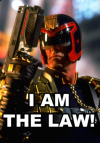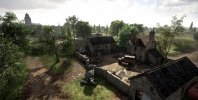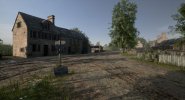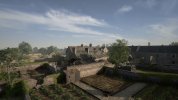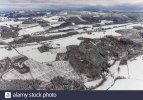I agree... I just suggested making them central to make it easier to produce all the maps.One thing I'd recommend about VLs, don't make them too big*, and make them an actual objective, ie, not an arbitrary patch of ground but a few buildings, a farmhouse, a copse, a bridge, a hill, something specific. This gives the objective a more realistic feel.
You are using an out of date browser. It may not display this or other websites correctly.
You should upgrade or use an alternative browser.
You should upgrade or use an alternative browser.
Western Front campaign anyone?
- Thread starter Concord
- Start date
Thanks for your input guys, I'm now leaning towards the platoon scale campaign. Could call it Platoon Leader!
At this scale there's a number of ways I can make it work, using the action cards.
They would be centered around abstract support from the parent battalion.
The deck of cards would be refreshed each campaign turn.
Examples:
A platoon that wants to specifically attack (or a platoon that is weak and expects to be attacked) can get reinforcements in the form of an extra squad for that turn.
There might be something like 3 of these to be distributed by the CO each turn.
Similarly, battalion reinforcement cards might be a machine gun section or a light mortar section, or a flamethrower team or a sniper...or any other support we decide to be in the deck.
The losses of these support units may or may not be tracked (abstracted battalion pool).
Each turn might see replacements trickle in. One green squad can be added to a platoon (permanently) by the CO every turn.
A light vehicle might be available to a platoon each turn.
Probably many more interesting ideas to be considered for the action cards.
Maybe even some special ones issued by the GM to cause trouble.
At this scale there's a number of ways I can make it work, using the action cards.
They would be centered around abstract support from the parent battalion.
The deck of cards would be refreshed each campaign turn.
Examples:
A platoon that wants to specifically attack (or a platoon that is weak and expects to be attacked) can get reinforcements in the form of an extra squad for that turn.
There might be something like 3 of these to be distributed by the CO each turn.
Similarly, battalion reinforcement cards might be a machine gun section or a light mortar section, or a flamethrower team or a sniper...or any other support we decide to be in the deck.
The losses of these support units may or may not be tracked (abstracted battalion pool).
Each turn might see replacements trickle in. One green squad can be added to a platoon (permanently) by the CO every turn.
A light vehicle might be available to a platoon each turn.
Probably many more interesting ideas to be considered for the action cards.
Maybe even some special ones issued by the GM to cause trouble.
Last edited:
One aspect that I have been trying to formulate in my mind is how simultaneous movement would play out.
You can imagine it could become chaotic, with different units from each side trying to move into each others hexes (and friendly vacated hexes).
To resolve this (the order of movement) we could use some initiative rules.
A die is rolled for each platoon which determines the order of who gets to move first.
The die roll result may be modified by unit leadership value (+1 or +2 to the roll), and maybe an action card.
On the most simple level, imagine 2 adjacent enemy platoons. Each has orders to move into the other's hex.
Who moves first (and therefore who's hex becomes the battle hex)?
You can then imagine much more complex situations, where platoons are moving all over the place, into enemy and friendly (about to be vacated) hexes.
This will need some consideration as to how it will work.
You can imagine it could become chaotic, with different units from each side trying to move into each others hexes (and friendly vacated hexes).
To resolve this (the order of movement) we could use some initiative rules.
A die is rolled for each platoon which determines the order of who gets to move first.
The die roll result may be modified by unit leadership value (+1 or +2 to the roll), and maybe an action card.
On the most simple level, imagine 2 adjacent enemy platoons. Each has orders to move into the other's hex.
Who moves first (and therefore who's hex becomes the battle hex)?
You can then imagine much more complex situations, where platoons are moving all over the place, into enemy and friendly (about to be vacated) hexes.
This will need some consideration as to how it will work.
I've been forming a germ of an idea the last few days.
The concept is a modern counter insurgency campaign, were NATO/American forces patrol an area (from their base) marked with insurgent counters face down showing a question mark '?'.
A platoon of infantry in Humvees travel to zone/hexes to investigate and either meet insurgents or it turns out to be bad intel.
Please forgive the really bad map, it's just concept art I guess.

The concept is a modern counter insurgency campaign, were NATO/American forces patrol an area (from their base) marked with insurgent counters face down showing a question mark '?'.
A platoon of infantry in Humvees travel to zone/hexes to investigate and either meet insurgents or it turns out to be bad intel.
Please forgive the really bad map, it's just concept art I guess.

@Nathangun the map looks good. Reminds me of the type of maps found in the FPS Squad.
That's actually quite easy and I think it worked well in Five Lions. Commanders issue orders for movement but also indicate an in game time they intend for that unit to be in their desired position by. (Within the time frame set for that game turn). The GM compares this with their opponent's move orders and shifts the units accordingly. If two units enter an end hex, the unit that moves later becomes the attack as the other unit got to terrain first. The latter unit arriving initiates the attack. If the units bump into each other or they both move into the target destination at roughly the same time (give an hour leeway either way), then the battle instead becomes a meeting engagement. This solves your repetitive battle type problem from before and also mixes up the times a bit for a bit of variety.One aspect that I have been trying to formulate in my mind is how simultaneous movement would play out.
I'd avoid using dice based rules completely as over the internet is an unknown for all sides as they can't be present for when you role the dice. Though we're a pretty good bunch here, you don't want any risk of disagreements cropping up between yourself as GM and the teams. Well except over events that actually happen in the campaign itself and the unforeseen consequences from the player's perspective.
Yep, that sums it up.That's actually quite easy and I think it worked well in Five Lions. Commanders issue orders for movement but also indicate an in game time they intend for that unit to be in their desired position by. (Within the time frame set for that game turn). The GM compares this with their opponent's move orders and shifts the units accordingly. If two units enter an end hex, the unit that moves later becomes the attack as the other unit got to terrain first. The latter unit arriving initiates the attack. If the units bump into each other or they both move into the target destination at roughly the same time (give an hour leeway either way), then the battle instead becomes a meeting engagement. This solves your repetitive battle type problem from before and also mixes up the times a bit for a bit of variety.
I'd avoid using dice based rules completely as over the internet is an unknown for all sides as they can't be present for when you role the dice. Though we're a pretty good bunch here, you don't want any risk of disagreements cropping up between yourself as GM and the teams. Well except over events that actually happen in the campaign itself and the unforeseen consequences from the player's perspective.
I have used dice solutions for who “steals the march†in simultaneous movement systems — never had any problems (maybe I just ooze integrity
any risk of disagreements cropping up between yourself as GM and the teams.
The GM's word is law!

Arent those more examples of company level assets?Similarly, battalion reinforcement cards might be a machine gun section or a light mortar section, or a flamethrower team or a sniper...or any other support we decide to be in the deck.
The losses of these support units may or may not be tracked (abstracted battalion pool).
Calling all grogs. I need some help. @Bootie and @Mad Mike come to mind, but I imagine there are many with historical interests on this forum.
I had a tinker with the map for this new western front campaign I'm going to build, and realized I could do with some photos of terrain as source material.
It has been easy to find for my modern campaign, with tons of drone photos of various spots.
I started searching the net and had a surprisingly hard time.
Most of the photos are quite close up and don't show much of the surrounding terrain.
The ones that do are often heavily urban areas rather than 'countryside'.
I can probably just use modern photos of European terrain.
But I imagine a modern farm probably looks different from a 1940's farm for example.
Can anyone provide, say, links to websites that have tons of WW2 photos that show terrain features?
Haven't decided whether to set it in France, Holland or Germany yet, and I don't think it really matters that much.
Any help appreciated.
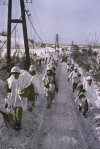
I had a tinker with the map for this new western front campaign I'm going to build, and realized I could do with some photos of terrain as source material.
It has been easy to find for my modern campaign, with tons of drone photos of various spots.
I started searching the net and had a surprisingly hard time.
Most of the photos are quite close up and don't show much of the surrounding terrain.
The ones that do are often heavily urban areas rather than 'countryside'.
I can probably just use modern photos of European terrain.
But I imagine a modern farm probably looks different from a 1940's farm for example.
Can anyone provide, say, links to websites that have tons of WW2 photos that show terrain features?
Haven't decided whether to set it in France, Holland or Germany yet, and I don't think it really matters that much.
Any help appreciated.

There was an official US military history site that had a whole bunch of aerial photos of Ardennes terrain and villages — maybe I’ll find it again.
Not really an expert but some collections of foto's from ww2 in NL (often uncategorized)

 beeldbankwo2.nl
beeldbankwo2.nl

 www.groningen4045.nl
www.groningen4045.nl

Beeldbank
Doorzoek ruim 150.000 foto’s, tekeningen, affiches en films over de Tweede Wereldoorlog bijeengebracht door het Nederlands Instituut Oorlogsdocumentatie.

Tweede Wereldoorlog in Groningen in 50 foto’s
De afgelopen maanden heeft De Verhalen van Groningen in samenwerking met de Groninger Archieven gezocht naar de meest aansprekende oorlogsfoto’s uit de provincie Groningen. Deze foto's werden verzameld voor het landelijke project Tweede Wereldoorlog in 100 foto’s uitgevoerd door het NIOD...
I've been thinking about the design of the maps.
At platoon size, there needs to be some cover, or the matches would bog down for fear of moving under fire in the open.
At the same time, I want to avoid too much repetition of the usual; too many woods, too many hedgerows. It will be a balancing act.
While the design of the MOUT campaign map was dominated by the use of buildings, I think slight elevation changes will be king here.
Since the story is that it's a quiet part of the line, the map will be a mix of rural farms, hamlets and other minor features, with some wilder areas.
I'm going to follow the design principle of the MOUT campaign map and put a central feature in each zone.
Some features will likely be repeated across the map.
There will be several farms I imagine, and I guess the best way to name them would be by the name of the owner (eg. Smith Farm).
So I will need to decide on which CMFB region I will set the campaign in. Any advice?
I'm guessing the operations in Germany would be unusual? German troops running low on numbers?
The Ardennes might be okay, although I want to avoid purely Battle of the Bulge stuff.
France maybe, although my impression is that there was a lot of activity with major attacks and counter attacks.
Holland, I don't know all that much about the nature of the war there.
Can anyone give me an insight into what region to choose?
At platoon size, there needs to be some cover, or the matches would bog down for fear of moving under fire in the open.
At the same time, I want to avoid too much repetition of the usual; too many woods, too many hedgerows. It will be a balancing act.
While the design of the MOUT campaign map was dominated by the use of buildings, I think slight elevation changes will be king here.
Since the story is that it's a quiet part of the line, the map will be a mix of rural farms, hamlets and other minor features, with some wilder areas.
I'm going to follow the design principle of the MOUT campaign map and put a central feature in each zone.
Some features will likely be repeated across the map.
There will be several farms I imagine, and I guess the best way to name them would be by the name of the owner (eg. Smith Farm).
So I will need to decide on which CMFB region I will set the campaign in. Any advice?
I'm guessing the operations in Germany would be unusual? German troops running low on numbers?
The Ardennes might be okay, although I want to avoid purely Battle of the Bulge stuff.
France maybe, although my impression is that there was a lot of activity with major attacks and counter attacks.
Holland, I don't know all that much about the nature of the war there.
Can anyone give me an insight into what region to choose?



























































































